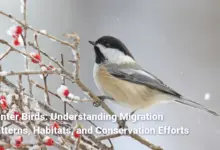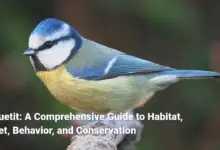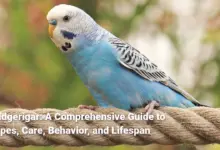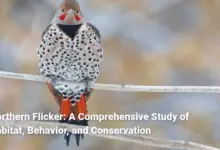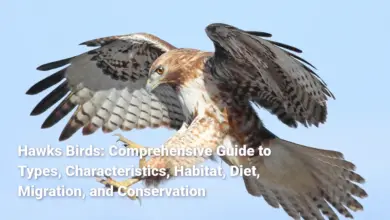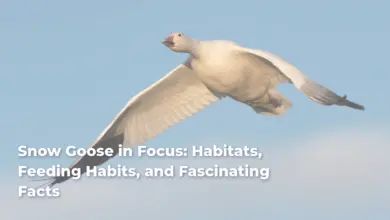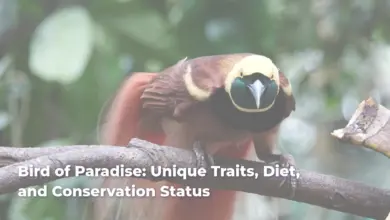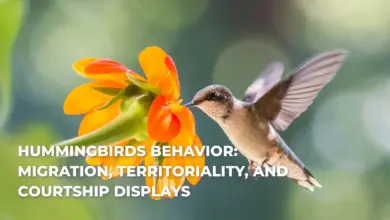Nighthawk Bird: Traits, Habitat, Feeding, and Conservation
A Comprehensive Look at the Nighthawk Bird's Features, Habitat, Feeding Behavior, and Conservation Efforts
Nighthawk Bird
Nestled between the realms of day and night, the Nighthawk Bird flutters gracefully through the twilight hours a sentinel of dusk that enchants those lucky enough to catch a glimpse. The Common Nighthawk (Nighthawk Bird), the most recognizable among its family, is not merely a bird; it’s a symbol of the fleeting beauty of transition. With its unique adaptations and intriguing behaviors, the nighthawk embodies the delicate balance between nature and the intricacies of its environment. This article will delve into the fascinating world of the nighthawk, exploring its characteristics, feeding habits, breeding practices, conservation status, and the challenges it faces in an ever-changing landscape.
As we embark on this journey, one can liken the nighthawk to a master of subtlety, expertly blending into its surroundings while captivating observers with its aerial acrobatics and haunting calls. If you’re a birdwatcher or just a nature enthusiast, viewing a nighthawk’s graceful flight as it swoops and dives for insects under the dusky sky can evoke feelings of wonder and curiosity. In our exploration, we’ll uncover the multifaceted aspects of this extraordinary creature, bringing forth stories that resonate with the heart and evoke a sense of connection to the natural world.
Characteristics of the Nighthawk Bird
The Common Nighthawk captivates observers with its distinct characteristics, representing an exquisite blend of form and function. You could think of it as nature’s perfect performer an avian artist that masterfully adapts to its surroundings.
- Size and Shape:
- This medium-sized bird boasts a slender body, long pointed wings, and a moderately long tail. Measuring approximately 8.7 to 9.4 inches (22 to 24 cm) in length, it weighs between 2.3 and 3.5 ounces (65 to 98 g), with a wingspan reaching 20.9 to 22.4 inches (53 to 57 cm).
- When in flight, its graceful body and wing structure allow for agile maneuvers, akin to a ballerina intertwining with the evening breeze.
- Coloration and Camouflage:
- A palette of rich greys, browns, and buffs adorns its plumage, providing camouflage that rivals that of a chameleon. When resting on the ground or among the leaves, one could say it becomes a ghost of the forest floor nearly invisible to both predators and passersby.
- Its long, dark wings feature a striking white patch, reminiscent of a flash of lightning visible during fleeting moments of flight.
- Head and Bill:
- With a relatively flat head and short neck, the nighthawk possesses a large-headed appearance. Its tiny bill, though inconspicuous, serves a critical role; it opens wide to capture flying insects in mid-air, designed much like a nature’s catcher’s mitt.
- Vocal and Flight Characteristics:
- The symphony of the nighthawk includes a unique, electric “peent” call that resonates primarily during its aerial displays a sound akin to a soft buzz emanating in the stillness of dusk.
- As it flits and loops through the sky, its flight resembles that of an acrobat performing a well-rehearsed routine, showcasing mastery in aerial dynamics.
- Sexual Dimorphism:
- Males are distinguished by more pronounced markings, particularly a prominent white throat, enhancing their attractiveness during courtship displays. This stark contrast in appearance is much like the art of persuasion each display a bid to capture the attention of a potential mate.
Through these diverse yet complementary characteristics, the Common Nighthawk becomes not just a bird of flight, but a marvel of ecological design an embodiment of the delicate interplay between survival and aesthetics in the realm of nature.
Physical Appearance
The physical appearance of the Nighthawk Bird is defined by a stunning array of features that contribute to its identity as a master of disguise and an agile hunter. Imagine a bird that can blend seamlessly into its surroundings while actively engaging in dynamic flight patterns this is the nighthawk’s artistry in motion.
One striking aspect is its size and shape. Nighthawks are medium-sized birds that exhibit a graceful silhouette with elongated wings and tails. With their bodies measuring about 8.7 to 9.4 inches long and weighing between 2.3 to 3.5 ounces, they present a delicate yet formidable appearance. Their wingspan, reaching from 20.9 to 22.4 inches, facilitates agile maneuvers, akin to a finely-tuned instrument gliding through open air.
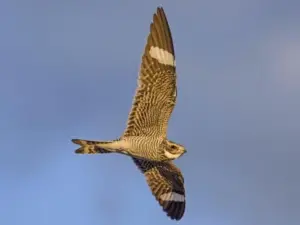
The coloration of the nighthawk is an intricate tapestry of browns, greys, and buff. This mottled pattern serves as an exceptional camouflage tool, allowing them to remain hidden against the backdrop of the ground or low vegetation. Much like a master painter dabbling with shades, the nighthawk’s plumage ensures it remains unseen by potential threats. The long, dark wings, adorned with distinct white patches, become a sudden revelation when the bird takes flight, creating a visually stunning contrast that advertises its presence.
The head and bill of the nighthawk add another dimension to its uniqueness. The flat head gives it an appealing charm, and the inconspicuous bill is deceptively small yet functional. Designated for catching insects mid-air, this specialized bill opens wide to embrace as many insects as possible, much like an umbrella unfurls to shield from rain.
The vocalizations of the nighthawk complement its appearance, adding an auditory layer to its mystique. The unique “peent” call heard during its aerial displays evokes the image of a lone musician playing a haunting melody in an empty auditorium.
The combination of its physical attributes shape, coloration, head structure, and vocalizations creates a compelling tableau of a bird destined to thrive amidst the dynamic relationships of the environment. The Common Nighthawk is, indeed, a remarkable species, perfectly embodying the art of camouflage while excelling as a charismatic performer of the skies.
Vocalizations and Calls
In the orchestra of avian sound, the Nighthawk Bird plays a unique role with its diverse and evocative vocalizations. Each call resonates with purpose, embodying the essence of its behavior and lifestyle. Much like a storyteller weaving a tale, the nighthawk communicates through auditory signals that hint at its presence, intentions, and emotional state.
Males exhibit a repertoire of distinctive calls, most notably the croaking “auk auk auk,” during courtship rituals. This call, often performed when near a female, seemingly beckons her attention an ancient ritual of avian courtship. Picture a bard conveying tales of valor! This call reaches its peak roughly 30 to 45 minutes after sunset, when twilight deepens and the world becomes hushed, an ideal backdrop for their evening serenade.
While in flight, nighthawks emit a nasal, “peent” call, adding depth to their aerial displays. This sound, reminiscent of a sudden gust of wind, is associated with their foraging behavior, as they dash through the air in pursuit of insects. It’s a testimony to their active lifestyle, as the sound punctuates the evening air filled with anticipation.
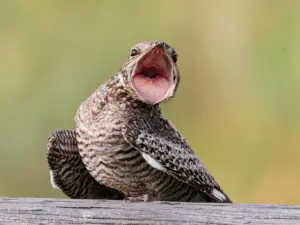
Females, not to be outdone, have their own vocal expressions. When guarding their nests, they may issue hissing or throaty clucks communication steeped in maternal instinct. Think of a mother bear, ready to defend her cubs, effectively signaling danger while safeguarding her family.
Yet perhaps the most spectacular vocal display emerges during courtship flight. As males dive from great heights, they generate a booming sound an auditory explosion created by air rushing through their wing feathers. This booming acts as a sonorous spotlight, drawing females closer and marking the male’s territory in an impressive aerial display.
Together, these vocalizations and calls create a sonorous habitat around the night hawk truly a symphony of nature! With their melodious croaks, sharp peents, and maternal hisses, nighthawks underscore their vital lives and breeding success through these instinctual and beautiful expressions.
Habitat and Distribution
The habitat and distribution of the Nighthawk Bird reflect its remarkable adaptability and resilience. Found across a broad landscape, these birds occupy various ecological niches that extend from the lush forests to bustling urban centers. Imagine a creature that dances seamlessly between the wild and the structured, embodying the essence of balance in nature.
The Nighthawk Bird thrives in open areas, preferring habitats like grasslands, savannas, and forests, where their unique hunting methods can flourish. Whether it’s the vast meadows or urban parks, nighthawks have shown an uncanny ability to thrive in environments that offer ample foraging opportunities. Their reliance on open spaces is akin to a painter preferring a blank canvas to express their creativity freedom to maneuver and explore.
During warmer months, these birds can be spotted not only in rural regions but also in cities, adapting to urban landscapes where they forage over bright lights attracting insects. Their adaptability highlights a crucial survival skill, as they can seamlessly switch from rural ecosystems to urban environments, showcasing their versatility in resource utilization.
Moreover, the migratory patterns of the Common Nighthawk are especially intriguing. Breeding across North America, they journey south through Central America and spend winters in Southern regions, extending their range and responding to seasonal changes as if guided by an ancient compass. Their migratory behavior enables them to exploit diverse ecosystems and maintain their populations in favorable environments much like an artist traveling to various galleries, drawing inspiration from different cultures.

In essence, the distribution of the Common Nighthawk is a testament to its ecological adaptability. By weaving through a tapestry of habitats, these birds ensure their presence and resilience in the face of ever-changing landscapes a striking phenomenon illuminated by the adaptability of nature itself.
Preferred Habitats
When considering preferred habitats, the Common Nighthawk exemplifies versatility and adaptability, showcasing its unique ability to thrive in a range of ecosystems. Envision a bird that dances between various terrains meadow, savanna, and urban sprawl seamlessly adapting wherever its journey takes it.
- Open Grasslands and Fields
- Nighthawks gravitate towards expansive grasslands and open fields where they can hunt for insects freely. Here, they soar above the tall grasses, capturing their airborne prey mid-flight.
- Forests and Wooded Areas
- While they prefer open areas, nighthawks often frequent edges of forests, woodlands, and even partially cleared patches. These locations provide an intricate balance of cover and availability of prey, allowing for effective foraging.
- Urban Environments
- Remarkably, Common Nighthawks have adapted to urban settings, nesting on flat, gravel rooftops where they can find solitude amidst bustling human activity. This adaptation showcases their versatility, garnering access to insects that swarm around streetlights and other artificial light sources.
- Beaches and Sand Dunes
- In coastal regions, nighthawks can thrive in sandy environments, utilizing the undisturbed landscapes to rest and forage. The open spaces provide ample opportunities to sight and snatch flying insects.
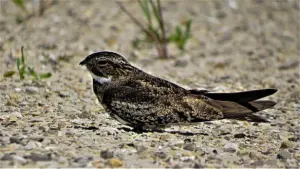
In summary, the Common Nighthawk’s preferred habitats reflect its necessity for open spaces filled with insects, showcasing its remarkable adaptability. This bird exemplifies resourcefulness, occupying diverse environments to maximize its foraging efficiency and reproductive success. It stands as a testament to nature’s wonders, highlighting how a species can navigate and thrive amid ever-evolving landscapes.
Global Range
The global range of the Nighthawk Bird reveals an avian traveler that skillfully navigates between continents, marked by migratory instincts and ecological adaptability. Imagine a bird that effortlessly transitions from the lush grasslands of North America to the vibrant landscapes of South and Central America this is the essence of the nighthawk’s migratory tapestry.
Breeding Grounds:
- The nighthawk primarily inhabits regions in North America during the breeding season, with their range spanning from southern Canada to the Gulf Coast of the United States. These areas, characterized by openness and accessibility to inundated insect populations, serve as prime nesting sites think of them as bustling neighborhoods filled with culinary delights.
Migration Patterns:
- During migration, the Common Nighthawk traverses through Central America, making their way down to the southern regions of South America for the winter. This expansive journey can cover thousands of miles, reflecting their adaptability and keen navigation skills akin to seasoned travelers mapping a journey through varied terrains.
Localized Distributions of Other Species:
- While the Common Nighthawk showcases a broad range, it’s essential to note that other nighthawk species exhibit more localized distributions. For instance, the plain-tailed nighthawk is primarily found in Brazil, emphasizing the diverse ecological niches of its family members.
The global distribution of the Common Nighthawk mirrors the broader patterns of avian migration an extraordinary narrative of resilience and exploration. This dynamic range highlights their ecological adaptability and success in colonizing diverse territories, ensuring their continued presence in vibrant, insect-rich landscapes.
Feeding Habits of the Nighthawk Bird
The feeding habits of the Nighthawk Bird reveal a specialized diet that hinges upon its territorial aerial hunting. This bird is not merely a passive creature; it embodies a rhythm of life that dances with the pulse of its environment.
Primarily an insectivore, the nighthawk feeds exclusively on flying insects. Its diet primarily consists of:
- Beetles
- Moths
- Ants
- Wasps
- Flies
- Mosquitoes
In essence, nighthawks are the aerial equivalents of skilled fishermen, casting their gaping mouths wide open to capture the fleeting moments of insect abundance.
The nighthawk’s feeding behavior is most prominent during twilight hours dawn and dusk. Much like the magical moments when day meets night, these times provide the most opportune moments for successful foraging. While primarily crepuscular, nighthawks may also engage in daytime foraging, particularly in stormy weather, embracing change as the winds shift.
A significant aspect of their feeding behavior exhibits adaptability, as their feeding patterns align with human-created sources of light. They often congregate around streetlights and stadium lights, capitalizing on the swarms of insects drawn to these artificial illuminations. It’s a choreographed ballet where the nighthawks thrive in the glow transforming urban landscapes into vibrant hunting theaters.
In summary, the feeding habits of the Common Nighthawk demonstrate a finely tuned ecological niche in the insectivorous circle of life. Their adept aerial foraging reflects an impressive ability to thrive amid the rhythmic fluctuations of nature, establishing their role as masters of the evening hunt.
Diet Composition
Delving into the diet composition of the Nighthawk Bird offers insights into its role as an aerial insectivore, showcasing a specialized palate nurtured by its environment. Envision a bird that dances gracefully through the air, capturing its prey with skill and agility this is the essence of the nighthawk’s feeding strategy.
The Common Nighthawk relies primarily on a diverse range of flying insects, with its diet composition primarily encompassing:
- Beetles: Feeding on various species, from ground beetles to ladybugs.
- Moths: Their nocturnal emergence presents a prime food source.
- Ants: Particularly during warmer months, when winged males swarm.
- Wasps: Captured mid-flight, offering protein-rich sustenance.
- Flies: These are abundant in open habitats, easily snatched during flight.
- Mosquitoes: Considering nighthawks thrive in wetland areas, these insects account for a significant portion of their diet.
This diet is especially targeted toward insects with a high availability during their foraging times, emphasizing the nighthawk’s strategic hunting preferences, aligning with their unique lifestyle.
Feeding Behavior:
- Most active during crepuscular hours, nighthawks maximize their foraging potential. Unlike diurnal birds, they have adapted to exploit twilight a time when insect activity peaks, much like a bustling market opening just for them.
Hunting Strategy:
- Nighthawks rely on a unique foraging technique, employing a series of elegant loops as they glide through the sky. Much like a painter delicately adding strokes onto a canvas, they gracefully stalk their prey, capturing insects mid-air with their wide mouths a visual testament to their skillful adaptations.
By focusing on an insect-rich diet that varies with seasonal availability, nighthawks demonstrate their efficiency as aerial hunters, blending skill with environmental cues. This intricate balance allows them to thrive, contributing meaningfully to the ecological web and underscoring their role as indispensable players in the natural world.
Hunting Techniques
The hunting techniques of the Nighthawk Bird are a testament to its evolution as a specialized aerial insectivore. This bird’s agility and adaptability shine through its methods for capturing prey.
- Aerial Foraging:
- The primary hunting technique employed by nighthawks is aerial foraging, where they glide and swoop through the air in search of flying insects. Their long wings facilitate smooth, agile flight, allowing them to cover large areas in search of meals.
- While foraging, nighthawks utilize a series of looping flight patterns, akin to a dancer performing an elegant pirouette. This gracefulness not only demonstrates their skilled aerial maneuvering but also aids in spotting potential prey from a distance.
- Feeding Time:
- Nighthawks are mostly crepuscular feeders, hunting during dawn and dusk when insect activity is at its peak. This twilight engagement mirrors the magical moments that dance between day and night, ensuring a vibrant display of life when it matters most.
- They are also known to forage during the day, particularly in overcast or stormy conditions when they take advantage of subdued lighting, much like a jewel thief waiting for the cloak of night to hide their deeds.
- Interaction with Light Sources:
- One of the remarkable adaptations of the nighthawk is its tendency to hunt around artificial light sources. Imagine a streetlamp drawing moths and flies like a beacon; nighthawks gather in these areas, exploiting the food sources attracted to the illumination.
- This behavior underscores their opportunistic feeding style and showcases a unique interaction with human-altered landscapes.
- Capturing Prey:
- At the critical moment of capturing prey, the nighthawk opens its large, cavernous mouth wide an action analogous to opening an umbrella during a rainstorm. With a significant mouth designed for engulfing insects, they can catch several insects in a single swoop.
- The nighthawk’s ability to adjust its flight dynamics and maintain keen eyesight during these maneuvers ensures it secures food efficiently, posturing them as adept hunters of the night.
By employing these sophisticated hunting techniques, the Common Nighthawk illustrates the complexities of its lifestyle as an aerial insectivore. Its ability to engage in a dance of life and light showcases the fine-tuned nature of survival within both natural and urban ecosystems an embodiment of adaptability in motion.
Breeding Behaviors of the Nighthawk Bird
The breeding behaviors of the Nighthawk Bird reflect a fascinating blend of unique adaptations designed to maximize reproductive success. When the lens of nature turns to courtship, nighthawks become vibrant actors in an intricate play of sound, movement, and instinct.
Males exhibit dramatic courtship displays that are not only visually striking but also serve the crucial purpose of attracting females. During the breeding season, males engage in aerial dances characterized by high-altitude circling and diving flights. It’s almost as if they perform a balletic routine against the canvas of the evening sky, calling out in a series of haunting notes and “peent” calls.
Their display culminates in a steep dive, creating a booming sound as air rushes through their wing feathers an auditory highlight of their performance. Consider this booming as the grand finale of a concert, designed to leave a lasting impression on the female nighthawks gliding below.
When it comes to nest-building, nighthawks take a different approach than many other bird species. Rather than constructing traditional nests, they lay their eggs directly on the open ground, often on gravel, sand, or bare soil. This choice is largely due to their reliance on camouflage, making their presence far less detectable to predators. By utilizing natural substrates to hide their eggs, they ensure a greater chance of survival for their offspring.
Typically, females select nest sites in areas that provide a strategic combination of visibility and cover, resembling a clever strategic planner positioning assets for optimal success. The female incubates a clutch of about two eggs for approximately 16 to 20 days, showing commitment that is crucial for the survival of the young nighthawks.
After the eggs hatch, both parents become involved in nurturing their chicks, which are precocial and leave the nest after about 17 to 18 days. The young nighthawks receive care from both parents. Their primary food source regurgitated insects caught in their aerial pursuits demonstrates collaboration and dedication as they raise the next generation.
Through its intricate breeding behaviors, the Common Nighthawk exemplifies the nuanced balance between instinct, environmental adaptation, and parental commitment. Each step, from courtship displays to the nurturing of young, echoes the symphony of life an ongoing cycle within nature’s grand narrative.
Nesting Practices
Nesting practices of the Nighthawk Bird represent unique adaptations to their environment, showcasing their instinctive strategies to enhance offspring survival. Rather than following the conventional route of constructing nests, nighthawks adopt a distinctly minimalist approach that befits their lifestyle.
Choose-the-Ground:
- Nighthawks lay their eggs directly on the ground in areas devoid of substantial vegetation. Ideal sites include gravel beaches, rocky outcrops, and even flat rooftops in urban environments. These choices mirror the simple elegance of imperfect art a canvas that reflects its surroundings and yet stands out in its own subtle way.
- Egg Characteristics:
- Clutches typically consist of two eggs, which are pale in color, ranging from creamy white to olive-gray, peppered with blotches of dark markings. This speckled pattern offers direct camouflage against the substrate, rendering them nearly invisible.
- The greatest survival strategy is based not on nesting structures but on how effectively they blend in with their surroundings a perfect depiction of nature’s artistry at work.
- Incubation:
- Females primarily incubate the eggs, demonstrating commitment to nurturing before the hatchlings emerge. Over the course of 16 to 20 days, the female may leave the eggs briefly during evenings to forage for food, ensuring a balance between the need for sustenance and the urgency to protect her developing young.
- Parental Care:
- After the chicks hatch, both parents engage in feeding, showing collaboration in nurturing their young. The chicks, well-camouflaged and active at hatching, remain in hiding until they are ready to fledge a clever strategy that minimizes vulnerability.
- The protective instinct of the parents stretches beyond feeding, as they engage in distraction displays to divert predators away from their vulnerable youngsters.
In conclusion, the nesting practices of the Common Nighthawk paint a compelling portrait of adaptation, blending minimalism and efficiency. This strategy showcases a remarkable ability to thrive despite the challenges posed by the environment an echo of nature’s ingenuity designed to ensure survival while perpetuating the cycle of life.
Parenting Roles
The parenting roles within the Nighthawk Bird‘s breeding cycle reflect a fascinating blend of cooperation and instinct. In a world where survival often hinges on teamwork, nighthawks shine as dedicated guardians of their young a dynamic duo committed to sustaining the lifeline of their species.
- Shared Responsibilities:
- Both male and female nighthawks share the responsibilities of caring for their chicks after hatching. While the female primarily incubates the eggs for approximately 16 to 20 days, the male acts as a supportive partner, often guarding the nesting area.
- Their dual roles create a stable environment, akin to a well-choreographed duet, each stepping in to fulfill necessary functions, enhancing the safety of their offspring.
- Feeding the Young:
- When the chicks emerge, typically two per clutch, parental cooperation continues during feeding. Each parent engages in catching insect prey and regurgitating it for their growing chicks. This not only provides necessary nutrition but also strengthens the bond between parent and young.
- After 18 days in the nest, the chicks are ready to fledge, yet parental care doesn’t cease immediately. Parents continue to support their young, ensuring a nurturing environment that extends their oversight well into the fledgling phase.
- Protection Strategies:
- To mitigate predator threats, both males and females employ various distraction strategies, drawing attention away from their nesting site. Imagine the tactics of a stage performer, luring the audience’s gaze away from the critical moment of the show.
- Distraction Displays: Parents may feign injury or engage in exaggerated movements, diverting attention away from the hidden chicks, ensuring their safety in the critical early days of life.
- Fledging and Independence:
- After leaving the nest, the fledglings continue to depend on their parents for food for approximately 30 days. During this period, both parents provide sustenance while guiding their young through the daunting transition into independence.
- This gradual process reflects the essence of parental support a nurturing hand that tenaciously fosters the growth and maturity of their offspring, ensuring they are prepared to soar independently into the world.
Through their cooperative parenting roles, the Common Nighthawk exemplifies the critical importance of familial bonds in birdlife. The nurturing methods of both male and female reflect a commitment to ensuring the survival and thriving of their progeny an ongoing narrative of love, unity, and adaptation woven intricately into the very fabric of their existence.
Conservation Status of the Nighthawk Bird
The conservation status of the Nighthawk Bird evokes a narrative of concern as its populations face significant decline due to various factors. Fluctuations in their numbers do not merely reflect individual species’ fates; they echo the broader health of entire ecosystems and the impacts of human activities.
The Common Nighthawk is classified as “Threatened” in Canada under the Committee on the Status of Endangered Wildlife in Canada (COSEWIC) and considered a “Bird of Conservation Concern” by the U.S. Fish and Wildlife Service. As populations have experienced sharp declines amounting to roughly 58% between 1970 and 2014 the call for urgent conservation action resonates louder than ever.
The core threats facing the nighthawk stem from:
- Habitat Loss: The degradation and loss of natural nesting habitats due to urbanization, logging, and agricultural development pose significant challenges. Areas where nighthawks traditionally nest gravel rooftops, open fields face frequent human encroachment.
- Climate Change: Global climate shifts also impact habitat availability and complexity, further aggravating survival challenges as they adapt to previously stable ecosystems becoming unsuitable.
- Pesticide Use: Increasing reliance on chemical pesticides contributes to declines in insect populations, reducing food availability for these aerial insectivores. The cascading effects of diminished prey base further complicate their survival, acting like a dissonant note in a well-rehearsed symphony.
Threats and Challenges of the Nighthawk Bird
The threats and challenges confronting the Common Nighthawk represent a complex interplay of natural and anthropogenic factors, prompting urgent attention for conservation efforts. These challenges are the undercurrents of a larger environmental narrative woven through the intricate tapestry of avian life.
- Habitat Loss:
- Urbanization and land-use changes have significantly degraded the habitats on which nighthawks depend. The transformation of gravel rooftops into smoother surfaces incompatible with nesting diminishes their nesting success like a painter losing access to the paint needed to complete a masterpiece.
- Pesticide Use:
- The reliance on non-selective pesticides threatens the insect populations that form the basis of the nighthawk’s diet. As the food web becomes disrupted, the nighthawk’s access to insect prey diminishes, creating a predatory domino effect that resonates through ecosystems.
- Climate Change:
- Altered climate patterns affect the availability of nesting habitats and food resources. As temperatures surge or climates shift, nighthawks face increased difficulties in adapting within traditionally favorable zones akin to a performer struggling to adjust to a suddenly changing stage.
- Increased Predation:
- Predation pressures from corvids, gulls, and domestic cats interfere with the nesting success of nighthawks. The loss of nests due to predation compounds the challenges they already face, adding further obstacles in the quest for survival.
In summary, the unique challenges and threats facing the Common Nighthawk result primarily from human activities and environmental shifts. Conservation strategies must consider these factors to protect this magnificent bird, ensuring it has the opportunity to navigate through an uncertain future.
Conservation Efforts
In response to ongoing declines, conservation efforts aimed at protecting the Common Nighthawk have taken diverse and crucial forms. As awareness of the species’ plight deepens, various initiatives and organizations have mobilized to implement strategies designed to counteract the challenges they face.
- Habitat Conservation:
- Efforts to protect and restore essential habitats are pivotal. Strategies include direct restoration of breeding grounds, preservation of urban nesting sites, and the promotion of environmentally friendly land management practices like a painter revitalizing a fading masterpiece to ensure its longevity.
- Research and Monitoring:
- Organizations such as the Smithsonian Migratory Bird Center employ advanced tracking techniques to monitor nighthawk populations. Using GPS technology to study their migratory behaviors allows researchers to collect vital insights into population dynamics, informing targeted conservation actions.
- Policy Advocacy:
- Conservation bodies, including the American Bird Conservancy, engage in advocacy to promote protective legislations targeting critical habitats. They champion policies that restrict harmful pesticide uses linked to nighthawk declines, pushing for regulations that aim to safeguard insect populations that serve as the nighthawk’s primary food source.
- Public Education:
- Grassroots campaigns to raise community awareness about nighthawk conservation have gained traction. These efforts encourage local engagement and highlight the importance of maintaining bird-friendly practices, such as reducing pesticide use and protecting nesting sites in urban areas. Engaging communities fosters a sense of stewardship, enabling individuals to contribute to the conservation effort in tangible ways.
- Research Initiatives:
- Ongoing studies aim to unravel migration patterns, nesting success, and the relationship between habitat conditions and nighthawk populations. By gaining insight into the challenges they face and the environments they thrive in, conservation measures can become more focused and effective.
Through these multifaceted conservation efforts, the Common Nighthawk is given a fighting chance against its dwindling populations. The commitment from scientists, policymakers, and communities alike underscores the vital importance of preserving this unique species as a beacon of ecological health and biodiversity.
In conclusion, the Common Nighthawk stands as an embodiment of the beauty, complexity, and fragility of our natural world. This enchanting bird, with its unique adaptations and haunting calls, serves as a reminder of our responsibility to protect the delicate balance of nature. Through continued awareness and concerted conservation efforts, there remains hope for the nighthawk to soar gracefully through the skies a symbol of resilience amidst the challenges of an ever-changing landscape.

